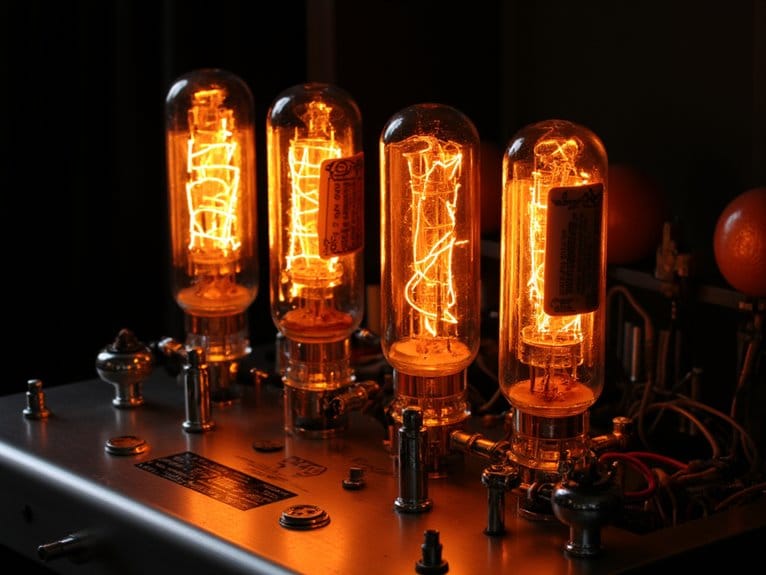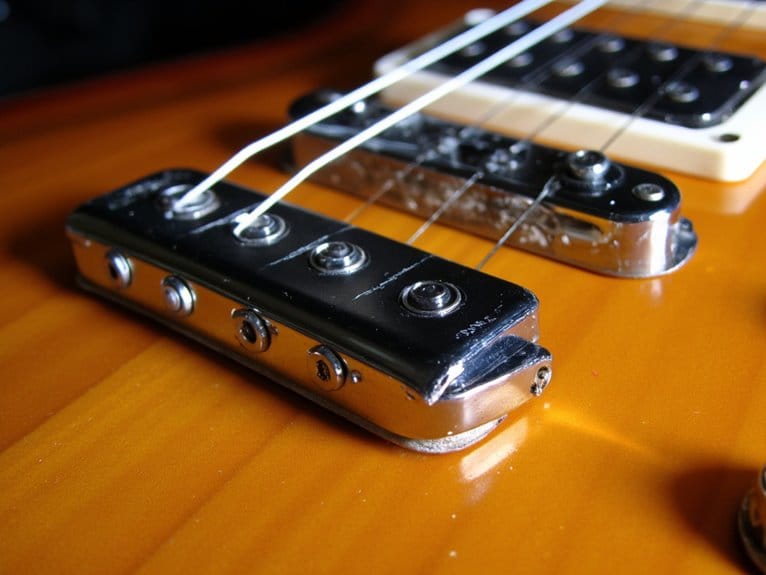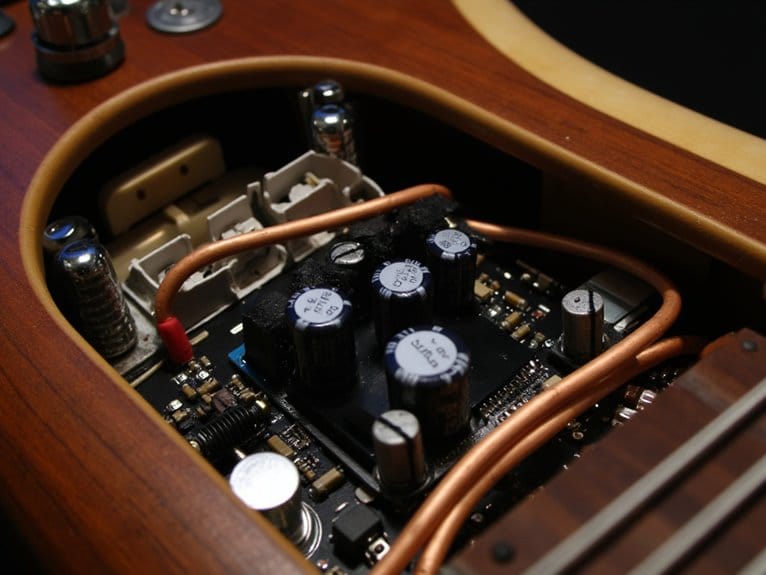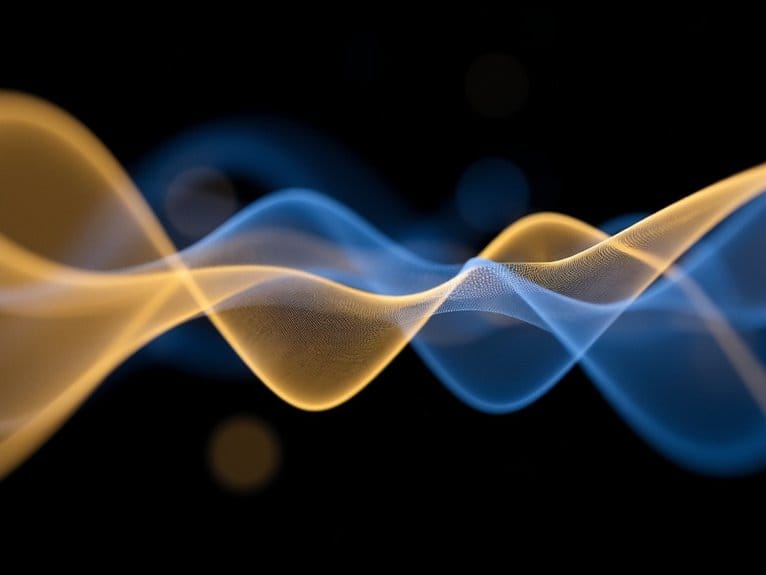How Vacuum Tubes Work in Guitar Amplifiers
When you plug into a tube amp, heated cathodes release electrons through thermionic emission in a controlled vacuum environment, where your guitar’s signal voltage applied to the control grid modulates this electron flow toward the plate, creating amplification with naturally occurring harmonic distortion that defines tube tone. Different tube types like 6L6s, EL34s, and 12AX7s each contribute unique gain characteristics and tonal signatures to your sound, while the vacuum prevents electron scattering for clean signal integrity—though there’s much more happening in this elegant process.
We are supported by our audience. When you purchase through links on our site, we may earn an affiliate commission, at no extra cost for you. Learn more.
Notable Insights
- Heated cathodes emit electrons through thermionic emission, creating electron flow in a vacuum environment toward the anode.
- Control grids modulate electron flow with small voltage changes from guitar pickups, producing dramatic amplified output variations.
- Vacuum environments eliminate air molecules, allowing clean electron travel without interference and preserving natural harmonic characteristics.
- Different tube types create distinct tonal signatures: 6L6s offer smooth breakup, EL34s provide aggressive midrange focus.
- Signal flows from input triodes through tone circuits to push-pull power tubes, then output transformers convert signals for speakers.
The Fundamental Components of Vacuum Tubes
Understanding vacuum tubes starts with their glass or metal envelope, which I’ve found creates the perfect environment for electron magic to happen inside your guitar amplifier.
The glass envelope becomes your tone’s sanctuary, where electrons dance and transform your guitar’s voice into pure sonic magic.
The component materials matter greatly—thick glass withstands heat while maintaining vacuum integrity, preventing oxidation that’d degrade your tone.
Inside, you’ll discover the filament, typically tungsten wire requiring 6.3V or 12.6V, heating the cathode to emit electrons through thermionic emission.
The control grid, positioned between cathode and anode, modulates electron flow where small voltage changes create massive plate current variations—that’s amplification in action.
Different tube configurations utilize additional electrodes like screen grids in tetrodes, reducing capacitance for improved performance, while the anode collects electrons at hundreds of volts, completing your signal’s journey. This even harmonic distortion contributes to the warm, natural sound quality that makes tube amplifiers so appealing to musicians and audio enthusiasts. Pentodes feature a suppressor electrode that prevents escaping electrons from degrading the tube’s overall performance.
Thermionic Emission and Electron Flow
When you flip on your tube amp, you’re witnessing thermionic emission in action, where the heated cathode releases electrons that travel through the vacuum toward the positively charged anode.
This electron flow occurs because the cathode’s temperature provides enough energy for electrons to escape the metal surface, while the vacuum environment guarantees they won’t collide with gas molecules during their journey.
You’ll find that controlling this electron stream through grid voltages is what allows your amp to amplify your guitar’s signal, transforming small input variations into the powerful output that drives your speakers.
Heated Cathode Electron Emission
At the heart of every vacuum tube lies a deceptively simple yet fascinating process called thermionic emission, where a heated cathode releases electrons that form the foundation of your guitar amp’s ability to amplify sound.
When you power up your amp, the cathode heater reaches incandescent temperatures, typically around 1,800°F, giving electrons enough energy to escape the metal surface.
Modern cathode materials use specialized coatings containing barium and strontium oxides that greatly improve emission efficiency compared to early tungsten filaments, reducing operating temperatures by roughly 1,000°F while increasing electron output.
- Heated cathodes create an electron “cloud” that regulates current flow through space charge effects
- Oxide coatings lower required temperatures and increase emission stability for consistent tone
- Indirect heating separates the filament from cathode, reducing unwanted hum in your signal
- Proper heater voltage guarantees ideal electron emission and extends tube lifespan considerably
Vacuum Environment Benefits
Why do vacuum tubes sound so fundamentally different from solid-state amplifiers, and what makes that glowing glass envelope so essential to your tone?
The vacuum environment delivers critical vacuum benefits that I’ve observed throughout decades of amp design, creating ideal conditions for electron efficiency that solid-state components simply can’t replicate.
Without air molecules interfering, electrons travel freely from cathode to anode with minimal collisions, maintaining their energy and trajectory for cleaner signal amplification.
This unobstructed electron flow eliminates the scattering and energy loss you’d experience in atmospheric conditions, while preventing unwanted ionization that would compromise your amp’s performance.
The vacuum also reduces electrical noise from random particles, preserving signal integrity and delivering those naturally smooth harmonic characteristics that define tube tone.
Electron Flow Control
While the vacuum environment sets the stage for pristine electron travel, the real magic happens when we fire up that glowing cathode and watch thermionic emission transform your guitar’s electrical signal into the warm, dynamic tone that’s made tube amps legendary for over half a century.
When you heat that cathode, electrons gain enough energy to escape the metal surface, creating a controllable cloud of charge that responds instantly to your playing dynamics.
The control grid acts as your tone’s gatekeeper, where small voltage changes from your guitar pickups create dramatic shifts in electron flow through sophisticated current modulation.
This grid dynamics system allows precise signal amplification while introducing those coveted harmonic characteristics that define tube tone.
- Heated cathode releases electrons through thermionic emission
- Control grid modulates electron flow with guitar signal variations
- Electron acceleration creates amplified current at the anode
- Nonlinear grid response generates signature tube harmonics and compression
Signal Amplification Through Grid Control
Now that you understand how electrons flow from cathode to plate, you’ll see how the control grid transforms your guitar’s weak signal into something powerful enough to drive speakers.
When you plug into your amp, that tiny voltage from your pickups gets applied to the grid, and even microscopic changes in grid voltage create dramatic swings in the electron current flowing to the plate.
This relationship between small input changes and large output variations is what makes tube amplification so effective, since the grid acts like a valve that can throttle the electron flow with remarkable sensitivity.
Grid Voltage Modulation Effects
When you pluck a guitar string and send that tiny electrical signal into a tube amplifier, the control grid becomes the gatekeeper that transforms your modest input into a powerful, amplified output through precise voltage modulation.
The grid voltage dynamics create the fundamental mechanism where your small AC signal fluctuates around the negative bias point, controlling electron flow from cathode to plate with remarkable precision.
- Signal Multiplication: Your input voltage changes get multiplied by the tube’s amplification factor, typically around 100 for a 12AX7.
- Nonlinear Response: Grid voltage swings create inherent nonlinearity that generates the harmonic-rich distortion characteristics guitarists crave.
- Dynamic Control: Positive voltage excursions reduce grid-cathode repulsion, allowing more electrons to flow toward the plate.
- Overdrive Generation: Excessive positive grid voltage causes grid current, introducing the coveted tube saturation sound.
Modern compact amplifiers like the FBA-10 and LEKATO Mini achieve tube-like tones through analog technology that mimics these grid voltage modulation effects in solid-state circuitry. These advancements have made it possible for musicians to obtain the best amp clean tone without the bulk and maintenance associated with traditional tube amplifiers. Compact amplifiers offer versatile sound shaping capabilities, allowing users to tailor their tone to specific styles and preferences. This convergence of technology ensures that players can enjoy rich, dynamic sound in a lightweight and portable package.
Electron Flow Control Mechanics
Inside your tube amplifier, the actual mechanics of electron flow control represent the physical foundation where signal amplification transforms from electrical theory into sonic reality. Your control grid acts as an electron valve, where negative voltage variations create precise changes in electron mobility between cathode and anode. When you apply input signals to the grid, small voltage swings modulate the electron stream intensity, producing amplified output variations at the plate.
| Grid Parameter | Effect on Electrons |
|---|---|
| Negative Voltage | Reduces flow intensity |
| Signal Variation | Modulates stream density |
| Grid Capacitance | Controls response speed |
Grid capacitance influences how quickly your tube responds to signal changes, affecting high-frequency performance and overall amplifier dynamics in your guitar’s signal chain.
Common Tube Types and Their Gain Characteristics
The heart of any tube amplifier’s voice lies in its power tubes, and I’ve spent countless hours comparing how different tube types shape your guitar’s tone through their unique gain characteristics. Understanding these tube classifications helps you predict the tonal variations you’ll experience before you even plug in.
Your amp’s sonic personality starts with its power tubes—each type offers a distinct tonal signature that defines your playing experience.
Each tube type delivers distinct gain behaviors that fundamentally alter your playing experience:
- 6L6 tubes provide high headroom with smooth, musical breakup that maintains clarity at volume
- EL34 tubes offer aggressive midrange focus with earlier distortion onset for rock tones
- EL84 tubes create complex harmonic distortion with bell-like chimey characteristics at lower power
- 6V6 tubes produce soft, chewy clipping with dynamic response perfect for blues styles
These differences stem from each tube’s electrical design and power handling capabilities.
Circuit Integration and Signal Path
Although power tubes grab most of the attention when guitarists discuss tone, I’ve learned that understanding how your signal travels through the complete circuit path reveals why certain amps respond so differently to your playing dynamics.
Your guitar’s signal first hits the input stage, where 12AX7 triodes provide impedance matching and initial voltage amplification. From there, it flows through tone control circuits that use capacitors and resistors to shape frequency response before reaching the second gain stage.
The circuit design becomes critical at the phase inverter, which splits your signal for push-pull power tubes. Finally, output transformers convert the high-voltage, low-current tube signal into something your speakers can handle, completing this intricate electronic journey.
The quality of these circuit components and their integration significantly affects the amplifier’s tonal performance and overall durability.
Frequently Asked Questions
Can I Replace a Vacuum Tube With a Different Type?
You can replace vacuum tubes with different types, but tube compatibility matters greatly. Some tube alternatives like EL34 and 6CA7 work interchangeably, while others risk damaging your amplifier due to mismatched electrical specifications.
How Much Does It Cost to Retube a Guitar Amplifier?
Retube pricing for your guitar amplifier typically ranges from $80-$200 total, depending on tube types and labor costs. Regular amplifier maintenance through professional retubing guarantees peak sound quality and extends your amp’s lifespan considerably.
Do Vacuum Tubes Need to Warm up Before Playing?
Yes, you’ll need tube warm up before playing. Cold tubes produce unstable sound and increased noise. The performance impact is significant – warmed tubes deliver better tonal response and smoother distortions you’re seeking.
On a final note
You’ve now grasped how vacuum tubes transform your guitar’s signal through thermionic emission, grid voltage control, and strategic circuit placement. Whether you’re running 12AX7 preamp tubes for initial gain staging or EL34 power tubes for final output amplification, you’ll recognize how electron flow manipulation creates that coveted tube saturation. Next time you’re adjusting your amp’s settings, you’ll understand the complex electronic processes happening inside those glowing glass bottles.







